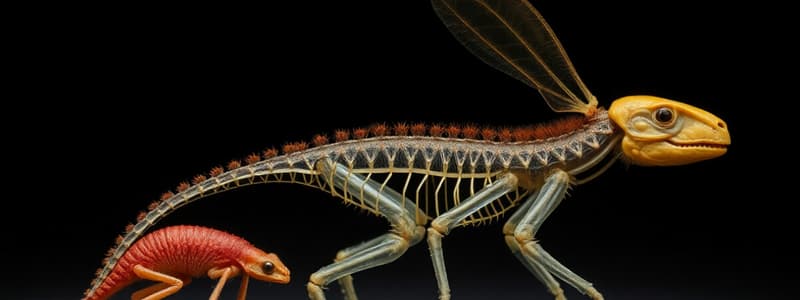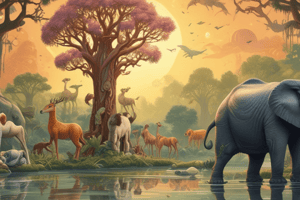Podcast
Questions and Answers
Which group is classified as a protist based on the evolutionary tree?
Which group is classified as a protist based on the evolutionary tree?
- Sarcopterygii
- Sponges
- Amniota
- Green Algae-Chlorophytes (correct)
What distinguishes the clade 'Vertebrata' from jawed fishes (Gnathostomes)?
What distinguishes the clade 'Vertebrata' from jawed fishes (Gnathostomes)?
- Vertebrata consists of lamprey and hagfish. (correct)
- Vertebrata does not include amphibians.
- Vertebrata includes sharks.
- Vertebrata exclusively contains reptiles.
Which of the following organisms does not belong to the deuterostome group?
Which of the following organisms does not belong to the deuterostome group?
- Chordates
- Amniotes
- Echinoderms
- Cnidarians (correct)
Which group is most closely related to mammals based on the tree of life?
Which group is most closely related to mammals based on the tree of life?
Which classification includes both red and green algae?
Which classification includes both red and green algae?
What is the significance of LUCA in the context of taxonomy?
What is the significance of LUCA in the context of taxonomy?
Which of these is not categorized as Amniota?
Which of these is not categorized as Amniota?
What is an example of a group that falls under bilaterians?
What is an example of a group that falls under bilaterians?
Which of the following groups is classified under Opisthokonts?
Which of the following groups is classified under Opisthokonts?
Which group is characterized as the first branch of the vertebrate lineage?
Which group is characterized as the first branch of the vertebrate lineage?
Which class of organisms shares a lineage with both reptiles and birds?
Which class of organisms shares a lineage with both reptiles and birds?
Which of the following is classified as an Archaea group?
Which of the following is classified as an Archaea group?
Which group encompasses all seed-producing plants?
Which group encompasses all seed-producing plants?
Which group is considered a protist according to its evolutionary classification?
Which group is considered a protist according to its evolutionary classification?
Which of the following groups is known for including animals that possess true tissues?
Which of the following groups is known for including animals that possess true tissues?
Which group is categorized as Deuterostomes?
Which group is categorized as Deuterostomes?
Which category includes organisms that are classified under Bilaterians?
Which category includes organisms that are classified under Bilaterians?
Which of the following organisms is a representative of the Chondrichthyes group?
Which of the following organisms is a representative of the Chondrichthyes group?
Flashcards are hidden until you start studying
Study Notes
Eukarya and Protists
- The protists belong to the Eukarya domain, consisting of various eukaryotic organisms.
- Common ancestor of protists is the eukaryotes, distinguishing them from other domains.
Tree of Life Overview
- Vertebrates are categorized under deuterostomes and bilaterians, showcasing the evolutionary lineage of animals.
- Sub-category Opisthokonts includes multiple significant groups leading to complex life forms.
Major Clades under Vertebrates
- Sarcopterygii: Lobe-finned fishes leading to tetrapods.
- Tetrapoda: Emphasizes the transition from aquatic to terrestrial life.
- Amniota: Grouping that includes reptiles, birds, and mammals, showcasing evolutionary adaptations.
- Reptilia: Diverse group comprising crocodilians, birds (Aves), turtles (Testudines), and lizards/snake.
- Great Apes: Encompasses modern humans (Homo sapiens), chimpanzees, and unique species like the duck-billed platypus.
- Mammalia: Diverse class including amphibians, lungfish, and ancient lineages like coelacanths.
- Amniota: Grouping that includes reptiles, birds, and mammals, showcasing evolutionary adaptations.
Protostomes and Other Life Forms
- Protostomes: Include several major groups like echinoderms (starfish), cephalopods (octopuses), and simpler organisms like sponges and cnidarians.
- Fungi and various protist groups (Amoebozoans, Stramenophiles) reveal early evolutionary forms and diversity.
Plant Lineage
- Angiosperms and Gymnosperms showcase the evolution of flowering and non-flowering plants.
- Green Algae: Includes stoneworts and chlorophytes, highlighting the diversity and evolutionary significance of aquatic plants.
- Red algae and other protist classifications (Rhizaria, Discoba) illustrate the complexity of photosynthetic life.
Microbial Life
- Archaea: Includes specific clades like Asgard and DPANN, representing early branching groups of life.
- Bacteria: Encompass major groups like proteobacteria and cyanobacteria, foundational to life on Earth.
Plants and Green Lineage
- Land Plants: The evolution of green plants, particularly within the Plantae group, marks significant adaptations for terrestrial environments.
- The classification into vascular plants and seed plants illustrates important evolutionary milestones in plant development.
Eukarya and Protists
- The protists belong to the Eukarya domain, consisting of various eukaryotic organisms.
- Common ancestor of protists is the eukaryotes, distinguishing them from other domains.
Tree of Life Overview
- Vertebrates are categorized under deuterostomes and bilaterians, showcasing the evolutionary lineage of animals.
- Sub-category Opisthokonts includes multiple significant groups leading to complex life forms.
Major Clades under Vertebrates
- Sarcopterygii: Lobe-finned fishes leading to tetrapods.
- Tetrapoda: Emphasizes the transition from aquatic to terrestrial life.
- Amniota: Grouping that includes reptiles, birds, and mammals, showcasing evolutionary adaptations.
- Reptilia: Diverse group comprising crocodilians, birds (Aves), turtles (Testudines), and lizards/snake.
- Great Apes: Encompasses modern humans (Homo sapiens), chimpanzees, and unique species like the duck-billed platypus.
- Mammalia: Diverse class including amphibians, lungfish, and ancient lineages like coelacanths.
- Amniota: Grouping that includes reptiles, birds, and mammals, showcasing evolutionary adaptations.
Protostomes and Other Life Forms
- Protostomes: Include several major groups like echinoderms (starfish), cephalopods (octopuses), and simpler organisms like sponges and cnidarians.
- Fungi and various protist groups (Amoebozoans, Stramenophiles) reveal early evolutionary forms and diversity.
Plant Lineage
- Angiosperms and Gymnosperms showcase the evolution of flowering and non-flowering plants.
- Green Algae: Includes stoneworts and chlorophytes, highlighting the diversity and evolutionary significance of aquatic plants.
- Red algae and other protist classifications (Rhizaria, Discoba) illustrate the complexity of photosynthetic life.
Microbial Life
- Archaea: Includes specific clades like Asgard and DPANN, representing early branching groups of life.
- Bacteria: Encompass major groups like proteobacteria and cyanobacteria, foundational to life on Earth.
Plants and Green Lineage
- Land Plants: The evolution of green plants, particularly within the Plantae group, marks significant adaptations for terrestrial environments.
- The classification into vascular plants and seed plants illustrates important evolutionary milestones in plant development.
Studying That Suits You
Use AI to generate personalized quizzes and flashcards to suit your learning preferences.




